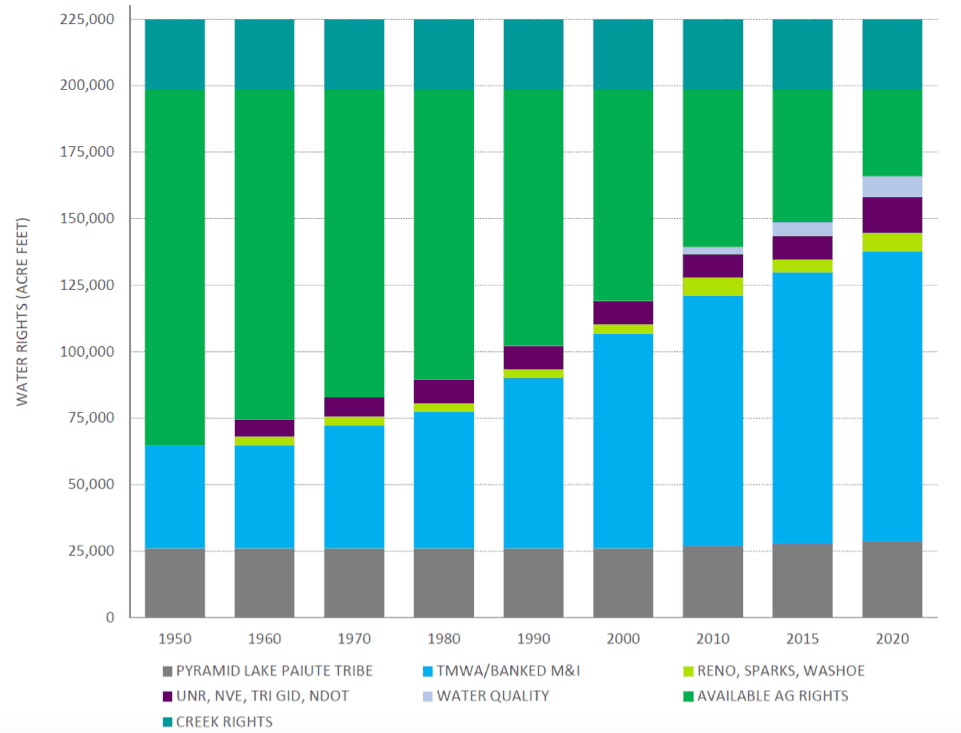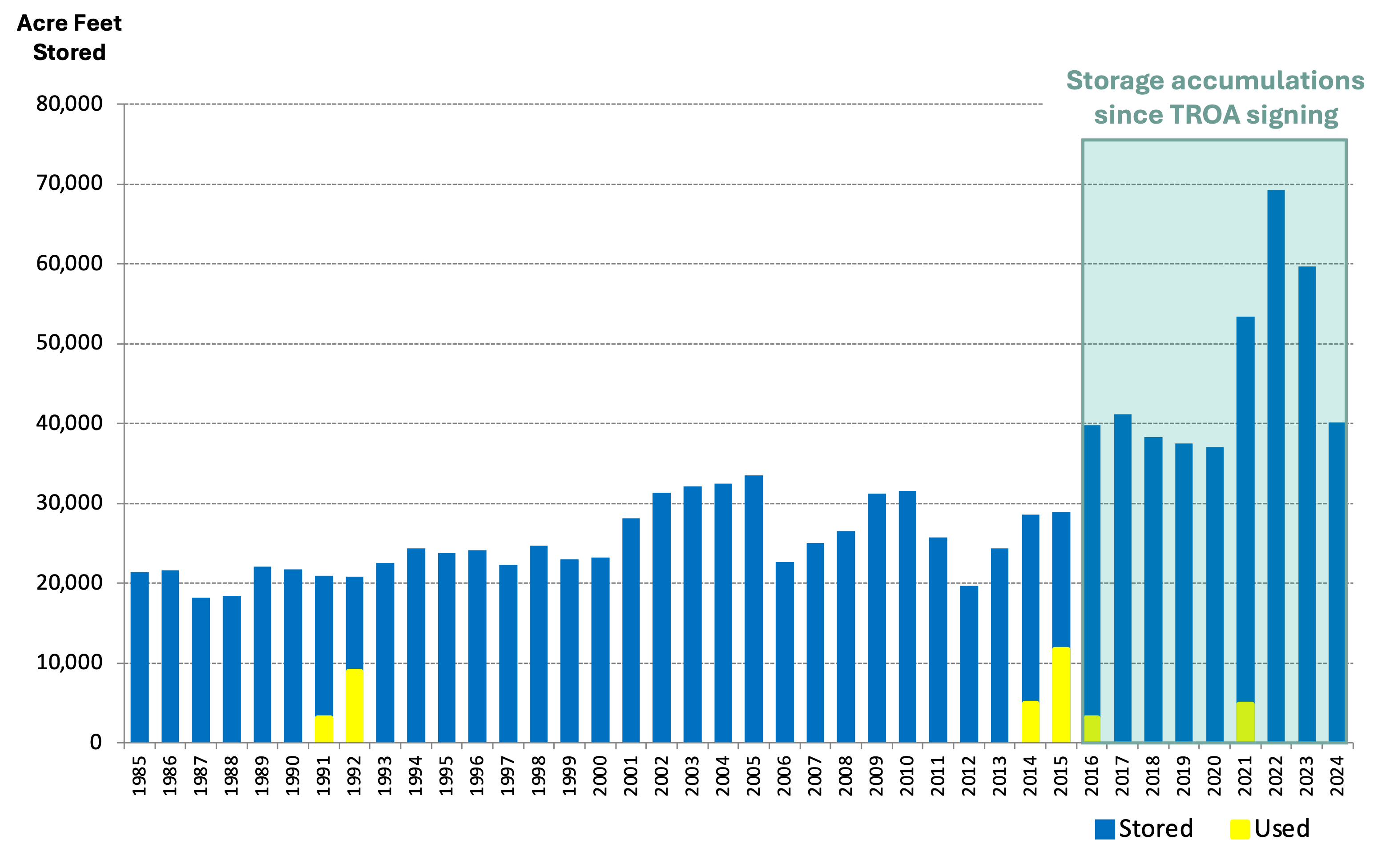Managing the Supply
How the Truckee River Operates
Flowing from Lake Tahoe Dam, the Truckee River meanders 121 miles through two states and multiple counties before finally terminating at Pyramid Lake, which is under the jurisdiction of the Pyramid Lake Paiute Tribe.
Management of the Truckee River is extremely complex and is detailed in the Truckee River Operating Agreement (TROA). This agreement is balanced to serve the needs of multiple stakeholders and uphold the legal operating conditions placed upon the river.
The ability to divert and use water from the Truckee River comes from ownership of a water right. There have been water right disputes on the Truckee River for well over 100 years. In 1944, the Orr Ditch Decree established the total number of water rights from the Truckee River and surrounding creeks.
Since then, no new Truckee River water rights have been, or can be, created.
Water Rights by Type and Ownership
While the number of water rights is set, use of Truckee River water has changed significantly over time.
For example, the chart below shows established water rights available on the Truckee River (225,000 acre feet) and how the use of those water rights have changed since 1950. The most common transfers have been from agricultural use (in green) into municipal use (in blue).

Overview of Lakes and Reservoirs
One of the main sources of water in the Truckee River is Lake Tahoe. It is North America’s largest alpine lake, and the largest reservoir on the Truckee River system. The Truckee River is Tahoe’s only outlet, and water released into the river is controlled by a small dam in Tahoe City, CA.
However, Tahoe is not the only source that feeds into the Truckee River system. There are five other reservoirs where water is stored and released into the river for many purposes, including municipal & industrial (M&I) use, hydropower, agriculture, fisheries, recreation, and flood control.
Three of those reservoirs (Prosser, Stampede, and Boca) are owned by the US Bureau of Reclamation and operated in conjunction with Lake Tahoe to provide, among other things, the required rates of river flow at the California-Nevada state line.
The other two reservoirs, Donner Lake and Independence Lake, are operated by Truckee Meadows Water Authority (TMWA) and can be used to supplement the river flow in order to help meet TMWA customer demands during drought periods.
Downstream of Reno and Sparks, a diversion at Derby Dam delivers Truckee River water through the 32-mile-long Truckee Canal to Fernley and continues to Lahontan Reservoir near Fallon. The natural terminus of the Truckee River is Pyramid Lake on the reservation of the Pyramid Lake Paiute Tribe.
The graph below shows the variability of Lake Tahoe water levels from 1986 to 2019. When water went below the natural rim during two of the most significant droughts on record (1987-1994 and 2012-2016), water was not available for release into the Truckee River from Lake Tahoe.

Managing River and Groundwater Together
Using groundwater in conjunction with other available water resources is an effective way to add redundancy to the drinking water supply in the Truckee Meadows. Managing surface and groundwater together as one integrated resource is called conjunctive use management.
Conjunctive use is an important strategy that makes the most efficient use of the water resources that Truckee Meadows Water Authority (TMWA) has available. This approach provides customers a reliable, high quality, and cost-effective water supply.
For example, about 85% of the water TMWA uses to serve customers comes from the Truckee River. Throughout the year, TMWA generally distributes as much of this surface water as possible throughout its service area.
When customer demand increases during summer months due to outdoor watering, TMWA brings groundwater production wells on-line. Groundwater wells can also be brought on-line during dry years when river flows are limited.
As the winter approaches, demand begins to taper down. This is when most of TMWA's production wells are taken off-line, as they are no longer needed for the water supply.
During the off-season, treated surface water is used to replenish groundwater aquifers. Over time, this can improve groundwater levels and offset the effects of summertime pumping.
Recharging groundwater with treated surface water and later pumping the water out to meet demand is also known as Aquifer Storage and Recovery (ASR). ASR is an integral component to the overall conjunctive use management strategy for TMWA.
Learn more about Water Topics in Our Community: Recharge Program
Understanding Stored Reserves
The Federal Water Master, who serves as the administrator of the Truckee River Operating Agreement (TROA), determines whether a 'drought situation' exists or not in April of each year.
When sufficient river flows cannot be maintained during drought years, Truckee Meadows Water Authority (TMWA) has several options to help meet customer demand.
- Augment the water supply with increased groundwater pumping.
- Release privately-owned water reserves into the Truckee River from Donner Lake and/or Independence Lake.
- Release credit water stored in *federal reservoirs** to supplement flows in the Truckee River, in coordination with the Federal Water Master under the terms of the TROA.
*In addition to Lake Tahoe, federal reservoirs on the Truckee River system include Stampede, Boca, and Prosser.
During designated drought years, water that TMWA has stored in federal reservoirs can be carried over into the following year and used to meet TMWA customer demand. Water conserved during drought can be also be held upstream for future use.
In multi-year droughts, TMWA can accumulate significant drought reserves, providing additional protection for the region's water supply that did not exist until the 2015 passage of TROA.
Below is a graph of the historic use of upstream drought reserves. It shows the amount of upstream storage TMWA had available, and the drought storage that was used to help meet customer demand during the 1987-1994 and the 2012-2016 droughts. Notably, since TROA was passed, the ability to store water during drought has significantly increased (in aquamarine shading):

TMWA’s Upstream Reserves Tracker is also updated daily.
Meeting Future Water Demand
Planning Never Stops
Water resource planning requires identifying a broad range of future conditions and determining the best strategies to meet the region's drinking water needs.
Since 2001, Truckee Meadows Water Authority has continually updated its Water Resource Plan which has helped steer the effective management of water resources from the lowest snowpack on record (2015) to the wettest water year on record (2017).
The 2020-2040 Water Resource Plan, finalized in October 2020, incorporates climate and population scenarios that effectively stress test the community's water system for the next 20 years and beyond.
For example, based on a continuation of population trends for the next 20 years, Truckee Meadows Water Authority projects a water demand increase of approximately 15%. When looking at these projections under multiple drought and climate scenarios, results show that the region's water supply is extremely resilient. These results are published in TMWA's 2020-2040 Water Resource Plan.
Participate and Learn
June 2025
Saturday, June 7 - Dancing on the River
6 p.m. - 10 p.m.
Happening on the first Saturday of each month. Free entry to dance lessons with food and drink trucks.
Wednesday, June 4 - Draft 2025-2045 Water Resource Plan Open House
VIRTUAL EVENT
5:30 p.m. - 6:30 p.m.
Join Truckee Meadows Water Authority and hear about the next update the region's long-term drinking water resource plan. Learn how to access the full plan and submit comments.